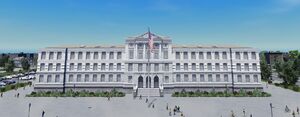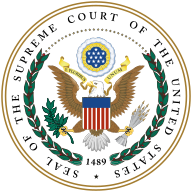United States Supreme Court
| This article is a sandbox, and is subject to change and revision. The final revision may differ greatly from this version. |
| United States | |
| Supreme Court |
The Supreme Court of the United States is in most respects, the highest Court in the United States on Matters of the Constitution and Laws of the United States (including Treaties of the United States): However, the actual highest Court in the United States on Matters of the federal Constitution and Laws is the Judicial Committee of the Federal Council, to which decisions of the Supreme Court may be appealed; But, in most Cases, the Judicial Committee declines to hear the case on appeal, thus letting the decision of the Supreme Court stand as controlling precedent. The Court was established in 1730 pursuant to Article II-D of the United States Constitution. The mission of the Supreme Court is to interpret and ensure the equal application of the United States Constitution across all twenty-eight States of the Union and their Territories. The Court reviews the constitutionality Federal and State Laws and Treaties vis-á-vis the United States Constitution; ensures that the several States and Territories comply with their obligations under the Federal Constitution; and interprets United States federal Law and federal Treaties. The Supreme Court is composed of twelve Associate Justices, plus the Chief Justice – there are currently 13 Justices – and it can only hear and decide Cases en banc.
It has [pen]ultimate (and largely discretionary) appellate jurisdiction over all Cases in federal Courts (including Territorial Courts) and over Cases in State Court involving Matters of the U.S. Constitution, Federal Law, Federal Treaties, and Federal regulations, plus original jurisdiction over a small range of Cases. In the legal system of the United States, the Supreme Court is, to most intents and purposes, the final [federal] interpreter of Federal constitutional Law, although it may only act within the context of Cases in which it is expressly vested with jurisdiction: However, decisions of the Supreme Court may be overturned by the Federal Council’s Judicial Committee. Furthermore, the Supreme Court is without any Authority to hear appeals of Cases or Controversies involving the Constitution or Laws of any State (including Treaties of any State), except exclusively in Cases or Controversies in which a party alleges a violation or usurpation of constitutionally-prescribed Federal authority or violation of Federal constitutionally-protected Rights: In all Cases or Controversies involving the Constitution or Laws of any State (including Treaties of any State), so long as the Case or Controversy does not involve a point of Federal law (Constitutional, statutory, treaty, or otherwise) but purely involving points of State law (Constitutional, statutory, or otherwise), the supreme Court of the State concerned is the final arbiter on the Matter; and as decisions by the Supreme Court which involve the interpretation and application of the United States Constitution may be overturned by the Federal Council’s Judicial Committee, the People forming the respective States are effectively the final interpreter of the Federal Constitution.
The Court consists of a chief Justice; and twelve associate Justices. Both the chief and associate Justices are nominated and, by and with the Advice and Consent of the U.S. Senate, are appointed by the Governor-General-in-Council. Once appointed, Justices serve during good behavior —Meaning that, in effect, their Commission lasts until they die, or retire; or are impeached and removed for “high crimes and misdemeanors”, which, in practice, would mean the Justice “breaking the law or even just behaving in a Manner that brings the Judiciary or the United States into ill repute” (though none have been as of yet removed).
The current Chief Justice is Andrew Napolitano, who was installed on the Court in 1731. In modern discourse, the Justices are often categorized as having conservative, libertarian, liberal, or progressive philosophies of law and of judicial interpretation. Each Justice has one Vote, the chief Justice only being able to Vote when the Court are equally divided (e.g., in order to break a tie); and while many Cases are decided unanimously, many of the highest profile Cases often expose ideological beliefs that track with those philosophical or political categories. The Court usually meet in the United States Supreme Court Building in the Fœderal Capital Territory; however, they occasionally sit elsewhere as part of their public outreach and civic engagement programs.
History[edit | edit source]
XXXX
Composition[edit | edit source]
XXXX
Size of the Court[edit | edit source]
XXXX
Appointment and confirmation[edit | edit source]
XXXX
Tenure[edit | edit source]
XXXX
Membership[edit | edit source]
XXXX
Current Justices[edit | edit source]
- Portrait-Timothy Mark Burgess.jpg
- Portrai-Barbara Lagoa (official).jpg
- Portrait-Benjamin Beaton.jpg
- Portrait-Leslie Southwick.jpg
- Portrait-James C Ho.jpg
Court demographics[edit | edit source]
XXXX
Retired Justices[edit | edit source]
XXXX
Seniority and seating[edit | edit source]
XXXX
Salary[edit | edit source]
XXXX
Judicial leanings[edit | edit source]
XXXX
Facilities[edit | edit source]
 |
||
|
||
The United States Supreme Court Building in the Fœderal Capital Territory is the primary seat of the Supreme Court. However, the Court also regularly sit at various places throughout the twenty-eight United States as part of their public outreach and civic engagement programs. |
XXXX
Jurisdiction[edit | edit source]
The Supreme Court is, for the most part, an appellate court; in the vast majority of cases, it does not hold trial, but merely reviews the facts of cases for error and constitutionality.
It has ultimate (and largely discretionary) appellate jurisdiction over all Federal, State, and Territorial court cases that involve a point arising under the Federal Constitution or any Law or Treaty made under the authority of the U.S. Constitution.
In its appellate role, the Supreme Court does not have authority to review Cases or Controversies arising under the Constitution or Laws of any State when there is no usurpation of constitutionally-prescribed Federal authority or violation of Federal constitutionally-protected Rights. It also has no jurisdiction over criminal convictions (except where violations of Federal authority or Federal constitutional guarantees are alleged), as the Federal Constitution exclusively vests all Powers over “crimes and criminal procedure” and “the administration of justice,” including “prescribing the punishment of violations of the laws of the United States” in the States respectively. Insofar as Federal constitutionally-protected Rights are observed and upheld, this exclusion of jurisdiction also extends to the form of punishment prescribed by State Legislatures.
However, within a narrow field of subject-matter, the Supreme Court is empowered to sit as a trial court. Instances where the Supreme Court may hold trial all encompass its original jurisdiction, which is fixed by the Federal Constitution as “all Cases affecting Ambassadors, other public Ministers and Consuls, and those in which a State shall be Party”. Furthermore, the Court has original and exclusive jurisdiction over Cases or Controversies between two or more States, but may decline to hear such disputes at its sole discretion. Additional to the Court’s original but not exclusive jurisdiction, it is also empowered, with like jurisdiction, to hear "all controversies between the United States and a State; and all actions or proceedings by a State against the citizens of another State or against aliens."
When sitting in its role as an appellate court, it may not issue findings of fact, and must accept such findings as were established at the trial court: However, when hearing cases or controversies arising within its sphere of original jurisdiction, the Supreme Court is empowered to issue such findings of fact as may pertain to the case or controversy at hand.
Process[edit | edit source]
XXXX
Case selection[edit | edit source]
XXXX
Oral argument[edit | edit source]
XXXX
Supreme Court bar[edit | edit source]
XXXX
Decision[edit | edit source]
XXXX
Published opinions[edit | edit source]
XXXX
Institutional powers and restraints[edit | edit source]
XXXX
Law clerks[edit | edit source]
XXXX
Politicization of the Court[edit | edit source]
XXXX
Criticism[edit | edit source]
XXXX













